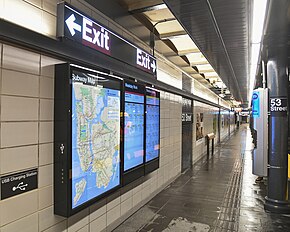 Global Information
Global InformationTechnology of the New York City Subway information

Since the late 20th century, the Metropolitan Transportation Authority has started several projects to maintain and improve the New York City Subway. Some of these projects, such as subway line automation, proposed platform screen doors, the FASTRACK maintenance program, and infrastructural improvements proposed in 2015–2019 Capital Program, contribute toward improving the system's efficiency. Others, such as train-arrival "countdown clocks", "Help Point" station intercoms, "On the Go! Travel Station" passenger kiosks, wireless and cellular network connections in stations, MetroCard fare payment alternatives, and digital ads, are meant to benefit individual passengers. Yet others, including the various methods of subway construction, do not directly impact the passenger interface, but are used to make subway operations efficient.
In the mid-1990s, it started converting the BMT Canarsie Line to use communications-based train control, using a moving block signal system that allowed more trains to use the tracks and thus increasing passenger capacity. After the Canarsie Line tests were successful, the MTA expanded the automation program in the 2000s and 2010s to include other lines. This led to a 2017 proposal to install platform screen doors in one Canarsie Line station. Additionally, as part of another program called FASTRACK, the MTA started closing certain lines during weekday nights in 2012, with each of the lines closing overnight for a week in order to allow workers to clean these lines without being hindered by train movements. The program was expanded beyond Manhattan the next year after noticing how efficient the FASTRACK program was compared to previous service diversions. In 2015, the MTA announced a wide-ranging improvement program as part of the 2015–2019 Capital Program. Thirty stations would be extensively rebuilt under the Enhanced Station Initiative, and new R211 subway cars would be able to fit more passengers.
The MTA has also started some projects to improve passenger amenities. It added train arrival "countdown clocks" to most A Division (numbered route) stations and the BMT Canarsie Line (L train) by late 2011, allowing passengers on these routes to see train arrival times using real-time data. A similar countdown-clock project for the B Division (lettered routes) and the IRT Flushing Line was deferred until 2016, when a new Bluetooth-based clock system was tested successfully. Beginning in 2011, the MTA installed "Help Point" to aid with emergency calls or station agent assistance, in all stations. Interactive touchscreen kiosks, which give station advisories, itineraries, and timetables, were installed starting in 2011. Cellular phone and wireless data in stations, first installed in 2011 as part of a pilot program, was expanded systemwide due to positive passenger feedback. Additionally, credit-card trials at several subway stations in 2006 and 2010 led to proposals for OMNY, a contactless payment system to replace the aging MetroCard system used to pay fares on MTA-operated transportation. Finally, in 2017, the MTA started installing digital advertisements in trains and stations.